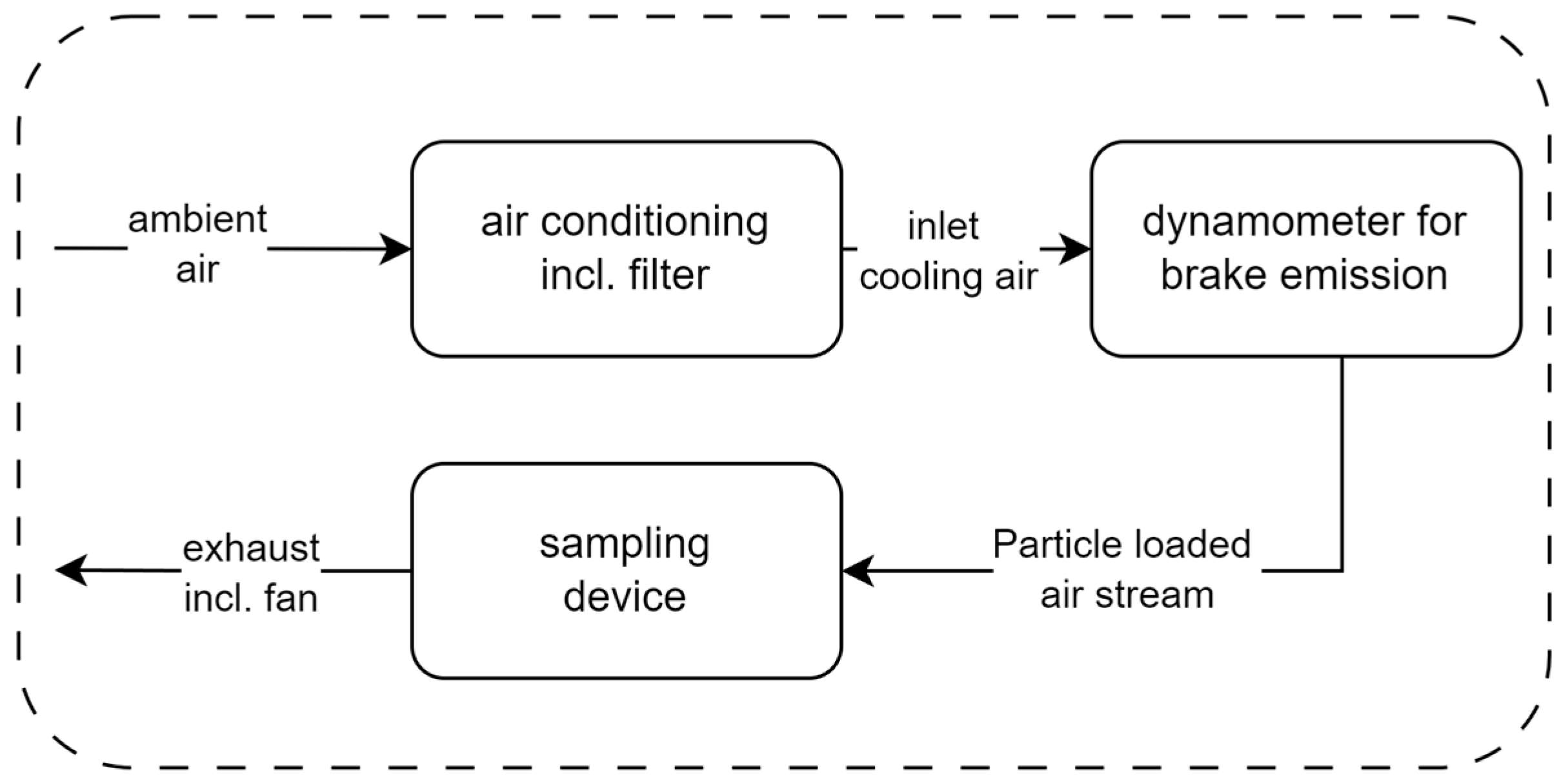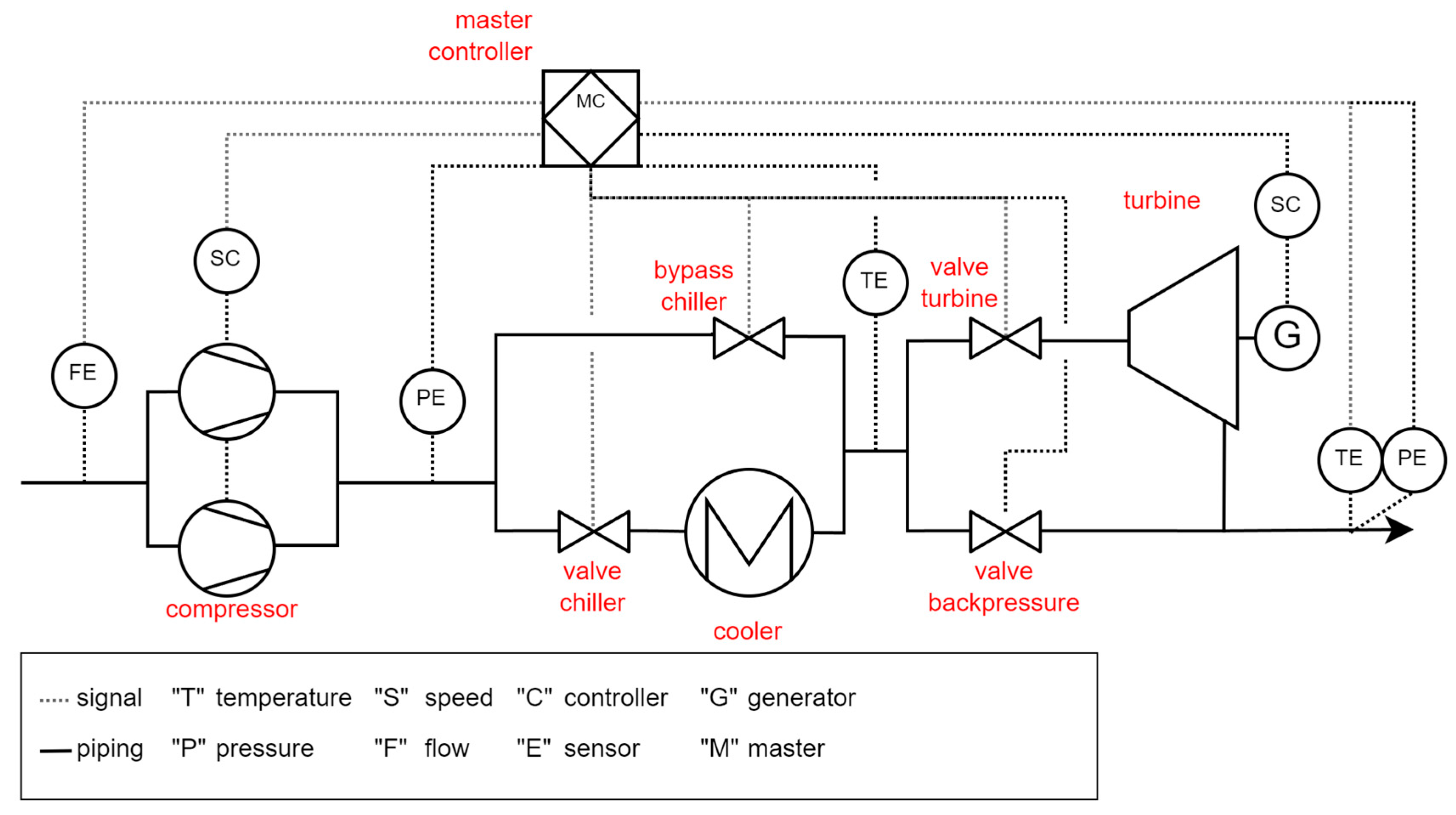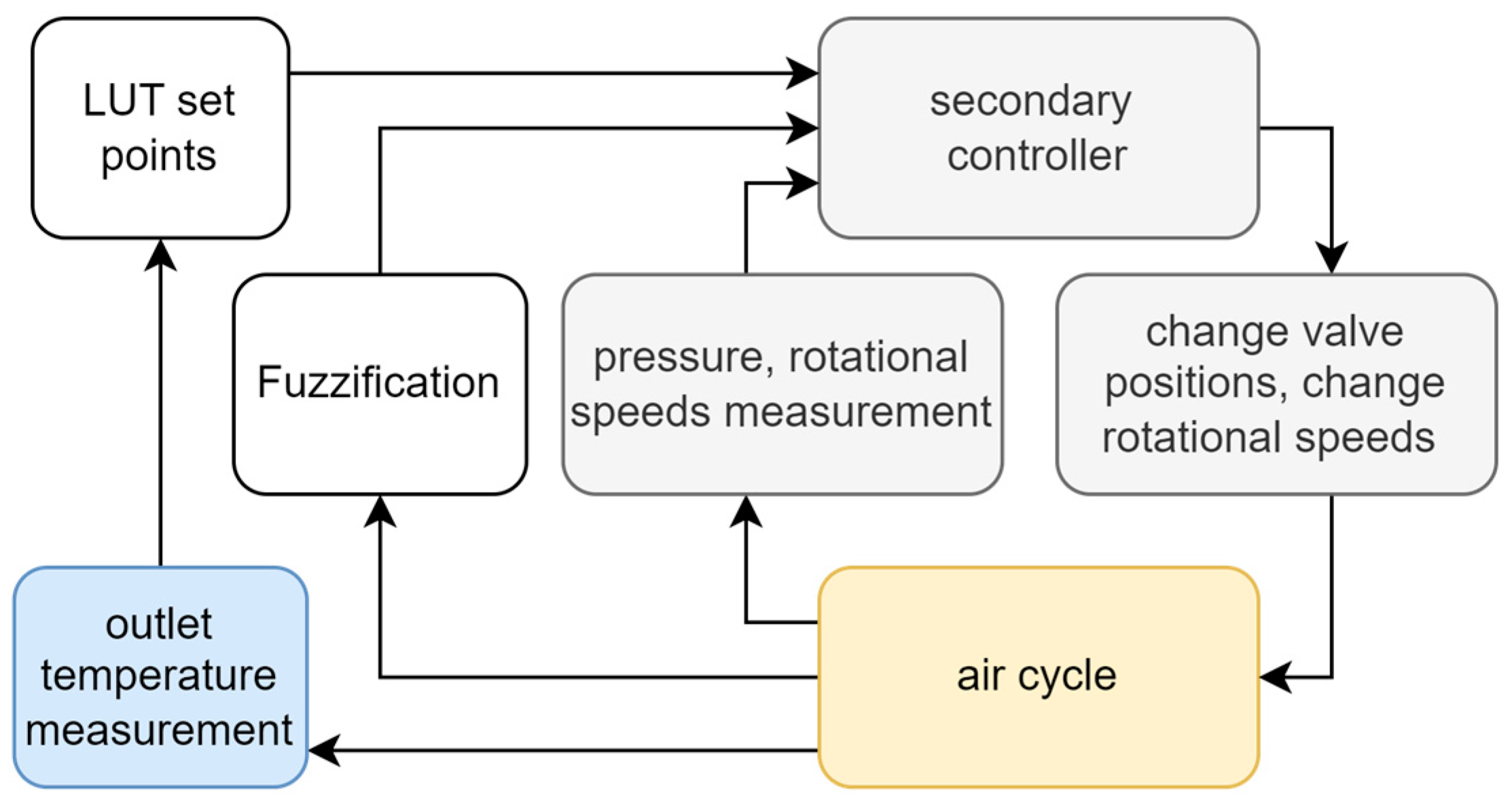Advancing Sustainable Refrigeration: In-Depth Analysis and Application of Air Cycle Technologies
Abstract
1. Introduction
2. Methodology
2.1. WLTP-B
2.2. Christof Air Cycle
2.3. Components
2.3.1. Valve
2.3.2. Compressor
2.3.3. Heat Exchanger
2.3.4. Radial Turbine
2.4. Design and Analysis—Radial Turbine
2.4.1. Geometric Modelling—pyTurbo
2.4.2. Off-Design Analysis and Stability Assessment
3. Results
3.1. Oprationsfield—Radial Turbine
3.2. Operation Map—Air Cycle
4. Discussion
Author Contributions
Funding
Data Availability Statement
Conflicts of Interest
Abbreviations
| Symbols | |||
| p | Pressure (Pa) | Heat capacity ratio (-) | |
| T | Temperature (K) | Heat capacity (J/kg·K) | |
| p01 | Total pressure at the outlet (Pa) | Pressure ratio (-) | |
| p5 | Static pressure at the outlet (Pa) | Power (W) | |
| Mass flow (kg/s) | Revolutions (rpm) | ||
| Tangential velocity (m/s) | U | Blade speed (m/s) | |
| Efficiency (-) | Volume flow (m3/h) | ||
| Specific enthalpy (J/kg) | Valve position (-) | ||
| Work (W) | Q | Heat flux (W) | |
| Polytropic coefficient turbine/compressor | |||
| Abbreviations | |||
| NURBS | Non-uniform rational B-Splines | RDE | Real Driving Emission |
| FEM | Finite elements method | WLTP | World-harmonized Light-duty Vehicles Test Procedure |
| CAD | Computer-aided design | COP | Coefficient of Performance |
| CFD | Computer fluid dynamics | APU | Auxiliary Power Unit |
| PID | Proportional–integral–derivative controller | PPA | Projected Polyhedron Algorithm |
| VCRS | Vapour compression refrigeration system | RANS | Reynolds-Averaged Navier–Stokes |
| GWP | Global warming potential | rpm | Revolutions per minute |
| SST | Shear stress transport | ||
References
- European Environment Agency. Greenhouse Gas Emissions from Transport in Europe. 2023. Available online: https://www.eea.europa.eu/en/analysis/indicators/greenhouse-gas-emissions-from-transport?activeAccordion=546a7c35-9188-4d23-94ee-005d97c26f2b (accessed on 15 April 2024).
- Air Quality Expert Group. Non-Exhaust Emissions from Road Traffic. 2019. Available online: http://uk-air.defra.gov.uk (accessed on 11 April 2024).
- Giechaskiel, B.; Grigoratos, T.; Dilara, P.; Karageorgiou, T.; Ntziachristos, L.; Samaras, Z. Light-Duty Vehicle Brake Emission Factors. Atmosphere 2024, 15, 97. [Google Scholar] [CrossRef]
- Fussell, J.C.; Franklin, M.; Green, D.C.; Gustafsson, M.; Harrison, R.M.; Hicks, W.; Kelly, F.J.; Kishta, F.; Miller, M.R.; Mudway, I.S.; et al. A Review of Road Traffic-Derived Non-Exhaust Particles: Emissions, Physicochemical Characteristics, Health Risks, and Mitigation Measures. Environ. Sci. Technol. 2022, 56, 6813–6835. [Google Scholar] [CrossRef] [PubMed]
- Dornoff, J.; Rodríguez, F. Euro 7: The New Emission Standard for Light-and Heavy-Duty Vehicles in the European Union. 2024. Available online: https://theicct.org/wp-content/uploads/2024/03/ID-116-%E2%80%93-Euro-7-standard_final.pdf (accessed on 8 August 2025).
- GRPE. Euro 7 New Proposal for Vehicle Emissions Type Approval in Europe (GRPE 87). 2023. Available online: https://unece.org/transport/events/wp29grpe-working-party-pollution-and-energy-87th-session (accessed on 13 April 2024).
- Publications Office of the EU. Euro 7 Impact Assessment Study; Publications Office of the EU: Luxembourg, 2022. [Google Scholar] [CrossRef]
- Mathissen, M.; Grochowicz, J.; Schmidt, C.; Vogt, R.; zum Hagen, F.H.F.; Grabiec, T.; Steven, H.; Grigoratos, T. A novel real-world braking cycle for studying brake wear particle emissions. Wear 2018, 414, 219–226. [Google Scholar] [CrossRef]
- Bondorf, L.; Köhler, L.; Grein, T.; Epple, F.; Philipps, F.; Aigner, M.; Schripp, T. Airborne Brake Wear Emissions from a Battery Electric Vehicle. Atmosphere 2023, 14, 488. [Google Scholar] [CrossRef]
- Hesse, D.; Augsburg, K.; Feißel, T. Real Driving Emissions Measurement of Brake Dust Particles. 2019. Available online: https://www.researchgate.net/publication/334671579 (accessed on 5 July 2025).
- Huber, M.P.; Fischer, P.; Mamakos, A.; Steiner, G.; Klug, A. Measuring Brake Wear Particles with a Real-Driving Emissions Sampling System on a Brake Dynamometer. In SAE Technical Papers; SAE International: Warrendale, PA, USA, 2022. [Google Scholar]
- Niemann, H.; Winner, H.; Asbach, C.; Kaminski, H.; Frentz, G.; Milczarek, R. Influence of disc temperature on ultrafine, fine, and coarse particle emissions of passenger car disc brakes with organic and inorganic pad binder materials. Atmosphere 2020, 11, 1060. [Google Scholar] [CrossRef]
- GRPE. Proposal for a New UN GTR on Laboratory Measurement of Brake Emissions for Light-Duty Vehicles (ECE/TRANS/WP.29/2023/79); GRPE: Geneva, Switzerland, 2023. [Google Scholar]
- Hammerschmidt, L.; Tielsch, M.; Spijker, C. Process air conditioning—The transition to air cycles in the automotive and mobility test infrastructure. In Proceedings of the Deutsche Kälte- und Klimatagung 2023, Hannover, Germany, 22–24 November 2023. [Google Scholar]
- Hammerschmidt, L. Development of a Radial Inflow Turbine for Sub-Zero Applications on an Automotive Dynamometer. Master’s Thesis, Montanuniversität Leoben, Leoben, Austria, 2020. [Google Scholar]
- Airtech AKB Series, AIRTECH Group Inc. Available online: https://www.airtechusa.com/media/AKB1000-Series-2020.pdf (accessed on 23 October 2025).
- Aungier, R.H. Turbine Aerodynamics: Axial-Flow and Radial-Flow Turbine Design and Analysis; ASME Press: New York, NY, USA, 2006. [Google Scholar] [CrossRef]
- Hammerschmidt, L.; Roanic, Z. Enhanced Turbomachinery Capabilities for OpenFOAM: Validation and Integration of a CAD Solution and Mixing-Plane. Int. J. Thermofluids 2025, 2, 101341. [Google Scholar] [CrossRef]
- Patrikalakis, N.M.; Maekawa, T.; Ko, K.H.; Mukundan, H. Surface to Surface Intersections. Comput.-Aided Des. Appl. 2004, 1, 449–457. [Google Scholar] [CrossRef]
- Patrikalakis, N.M.; Maekawa, T. Shape Interrogation for Computer Aided Design and Manufacturing; Springer: Berlin/Heidelberg, Germany, 2010. [Google Scholar] [CrossRef]
- Lee, H.G.; Shin, J.H.; Choi, C.-H.; Jeong, E.; Kwon, S. Partial admission effect on the performance and vibration of a supersonic impulse turbine. Acta Astronaut. 2018, 145, 105–115. [Google Scholar] [CrossRef]
- Alshammari, F. Radial Turbine ExpanderDesign, Modelling and Testing for Automotive Organic Rankine Cycle Waste Heat Recovery. Ph.D. Thesis, Brunel University, London, UK, 2018. [Google Scholar]
- Beaudoin, M.; Nilsson, H.; Page, M.; Magnan, R.; Jasak, H. Evaluation of an improved mixing plane interface for OpenFOAM. In IOP Conference Series: Earth and Environmental Science; Institute of Physics Publishing: Montreal, QC, Canada, 2014. [Google Scholar] [CrossRef]
- Hanimann, L.; Mangani, L.; Casartelli, E.; Mokulys, T.; Mauri, S. Development of a novel mixing plane interface using a fully implicit averaging for stage analysis. J. Turbomach. 2014, 136, 081010. [Google Scholar] [CrossRef]
- Gisbert, F.; Corral, R. A Novel mixing plane method using nonreflecting boundary conditions for multirow analysis in turbomachines. J. Turbomach. 2016, 138, 071009. [Google Scholar] [CrossRef]
- Cvijetić, G.; Jasak, H. Harmonic Balance Method for Turbomachinery Applications. In OpenFOAM®; Springer International Publishing: Cham, Switzerland, 2019; pp. 223–233. [Google Scholar] [CrossRef]
- Oliani, S.; Casari, N.; Carnevale, M. A New Framework for the Harmonic Balance Method in OpenFOAM. Machines 2022, 10, 279. [Google Scholar] [CrossRef]
- Hall, K.C.; Thomas, J.P.; Clark, W.S. Computation of Unsteady Nonlinear Flows in Cascades Using a Harmonic Balance Technique. AIAA J. 2002, 40, 879–886. [Google Scholar] [CrossRef]
- Hanimann, L.; Mangani, L.; Casartelli, E.; Gröschel, E.; Fischer, M. Steady-state fluid-solid mixing plane to Replace transient conjugate heat transfer computations during design phase. Int. J. Turbomach. Propuls. Power 2021, 6, 6. [Google Scholar] [CrossRef]
- Hoerner, S. Characterization of the Fluid-Structure Interaction on a Vertical Axis Turbine with Deformable Blades. Available online: https://theses.hal.science/tel-02895310 (accessed on 8 June 2025).
- Gadda, A.; Mangani, L.; Romanelli, G.; Mantegazza, P.; Casartelli, E. A GPU-accelerated compressible RANS solver for Fluid-Structure Interaction simulations in turbomachinery. In Proceedings of the International Symposium on Transport Phenomena and Dynamics of Rotating Machinery, ASME, 2016, Honolulu, HI, USA, 10–15 April 2016; Available online: https://hal.science/hal-01890058 (accessed on 9 June 2025).
- Rogo, C.; Hajek, T.; Chen, A.G. Variable Stator Radial Turbine; NASA: Washington, DC, USA, 1984. [Google Scholar]
- Okazaki, Y.; Matsuo, E.; Matsudaira, N.; Busch, P. Development of a variable area radial turbine for small turbochargers. In Proceedings of the ASME Turbo Expo; American Society of Mechanical Engineers: New York, NY, USA, 1988; Volume 2. [Google Scholar] [CrossRef]
- Binder, N.; Le Guyader, S.; Carbonneau, X. Analysis of the variable geometry effect in radial turbines. J. Turbomach. 2011, 134, 041017. [Google Scholar] [CrossRef]
- PROF. DIPL.-ING. PETER F. ORLOWSKI: Prozessoptimierung ohne Reglerparameter Die FRt-Wurzelrekursion. Technische Hochschule Mittelhessen. Available online: https://www.thm.de/me/images/user/orlowski-50/Prozessoptimierung-ohne-Parameter.pdf (accessed on 25 May 2025).
- Orlowski, P.F. Praktische Regeltechnik; Springer: Berlin/Heidelberg, Germany, 2008. [Google Scholar] [CrossRef]
- Li, P.; Irwin, G.W.; Kruger, U. A recursive rule base adjustment algorithm for a fuzzy logic controller. Fuzzy Sets Syst. 2005, 156, 267–284. [Google Scholar] [CrossRef]
- Sun, Y.L.; Er, M.J. Design of a recursive fuzzy controller with nonlinear fuzzy rule base. In Proceedings of the 7th International Conference on Control, Automation, Robotics and Vision, 2002, ICARCV 2002, Marina Mandarin, Singapore, 2–5 December 2002; pp. 1574–1578. [Google Scholar] [CrossRef]









| Parameter | Value | Unit |
|---|---|---|
| Air flow | 0.44 | |
| Total inlet pressure | 195,000 | |
| Total inlet temperature | 280 | |
| Outlet pressure | 90,000 | |
| Rotational speed | 25,000 |
Disclaimer/Publisher’s Note: The statements, opinions and data contained in all publications are solely those of the individual author(s) and contributor(s) and not of MDPI and/or the editor(s). MDPI and/or the editor(s) disclaim responsibility for any injury to people or property resulting from any ideas, methods, instructions or products referred to in the content. |
© 2025 by the authors. Licensee MDPI, Basel, Switzerland. This article is an open access article distributed under the terms and conditions of the Creative Commons Attribution (CC BY) license (https://creativecommons.org/licenses/by/4.0/).
Share and Cite
Hammerschmidt, L.; Raonic, Z.; Tielsch, M. Advancing Sustainable Refrigeration: In-Depth Analysis and Application of Air Cycle Technologies. Thermo 2025, 5, 52. https://doi.org/10.3390/thermo5040052
Hammerschmidt L, Raonic Z, Tielsch M. Advancing Sustainable Refrigeration: In-Depth Analysis and Application of Air Cycle Technologies. Thermo. 2025; 5(4):52. https://doi.org/10.3390/thermo5040052
Chicago/Turabian StyleHammerschmidt, Lorenz, Zlatko Raonic, and Michael Tielsch. 2025. "Advancing Sustainable Refrigeration: In-Depth Analysis and Application of Air Cycle Technologies" Thermo 5, no. 4: 52. https://doi.org/10.3390/thermo5040052
APA StyleHammerschmidt, L., Raonic, Z., & Tielsch, M. (2025). Advancing Sustainable Refrigeration: In-Depth Analysis and Application of Air Cycle Technologies. Thermo, 5(4), 52. https://doi.org/10.3390/thermo5040052





